The Twin Fuel tank set up I have in Desert Storm is perhaps not to everyone's tastes but there might be elements of it that could help you in the design of your own twin tank system. No rear filler, electronic solenoids to control it and the mechanical fuel pump does the work moving the fuel around.
Even though the Moke itself is a 1972 Export Moke with the mounts and holes in the body to suit the rear filler, one of my requirements was not to have a normal rear filler due to the loss of space it creates and where my roll bar mounts. To this end I developed a system where the fuel from the side tank is pumped into the rear tank via the normal mechanical fuel pump which was also intended to allow fuel to be constantly returned to the rear tank to prevent vapourising on hot days which was happening to me the 45 degree day I devised the system.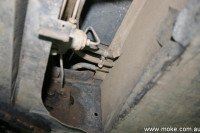 When I first built Desert Storm in the mid 90's I had fitted a standard side tank as the export rear tank was rusted out so when it came to making a rear tank in 2006 I simply designed a stainless steel box tank that mounted to the original rear tank mounts. To overcome the issue of no rear filler I had three pipes installed to handle inlet, outlet and breather all using a 6mm std fuel hose and planned to have the std fuel pump bring the fuel from the front of Moke.
When I first built Desert Storm in the mid 90's I had fitted a standard side tank as the export rear tank was rusted out so when it came to making a rear tank in 2006 I simply designed a stainless steel box tank that mounted to the original rear tank mounts. To overcome the issue of no rear filler I had three pipes installed to handle inlet, outlet and breather all using a 6mm std fuel hose and planned to have the std fuel pump bring the fuel from the front of Moke.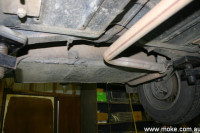 One issue with the rear tank option is what to do with the exhaust pipe and the easiest solution for me was to follow the factory option of going around the edges of the sub-frame but due to the planned trips, the muffler is mounted across the rear of the car under the bumper. For a road going car you could go straight under the tank and perhaps not have the tank as deep as I built.
One issue with the rear tank option is what to do with the exhaust pipe and the easiest solution for me was to follow the factory option of going around the edges of the sub-frame but due to the planned trips, the muffler is mounted across the rear of the car under the bumper. For a road going car you could go straight under the tank and perhaps not have the tank as deep as I built.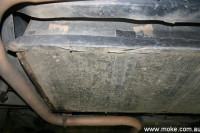 The next consideration regarding the rear tank was to install some protection from the stones and roads I was taking so originally I started with a a piece of 6mm rubber sheet on the front edge and a sheet of Masonite across the bottom of the tank, which did last a while but not long enough. Somewhere along the way I got some more rubber sheeting and covered the whole bottom and glued it on with Windscreen sealant which was all I could get at the time, but has proved much better than some of the other compounds I had used when it came to sticking rubber to stainless steel. Not clear in the photo but the tank has taken quite a beating and the rubber is doing its job well.
The next consideration regarding the rear tank was to install some protection from the stones and roads I was taking so originally I started with a a piece of 6mm rubber sheet on the front edge and a sheet of Masonite across the bottom of the tank, which did last a while but not long enough. Somewhere along the way I got some more rubber sheeting and covered the whole bottom and glued it on with Windscreen sealant which was all I could get at the time, but has proved much better than some of the other compounds I had used when it came to sticking rubber to stainless steel. Not clear in the photo but the tank has taken quite a beating and the rubber is doing its job well.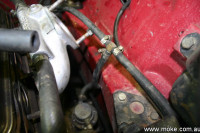 Up in the engine bay the changes are very simple to have the mechanical fuel pump used to fill the rear tank as you can see in the image a t-piece in the line between the fuel pump and the carby sends any fuel the carby doesn't need to the rear tank. The mod you can't see is a third hole in the firewall to accommodate the return hose.
Up in the engine bay the changes are very simple to have the mechanical fuel pump used to fill the rear tank as you can see in the image a t-piece in the line between the fuel pump and the carby sends any fuel the carby doesn't need to the rear tank. The mod you can't see is a third hole in the firewall to accommodate the return hose.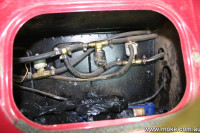 The most expensive part is the control system of three electrically operated solenoid that each shut off one of the hoses, either of the tanks or the return line to control filling of the rear tank. mounted in the sidebox and inherently dealing with fumes this part of the set up needs special attention to ensure all the electrical fittings, no spade terminals allowed here, are secured and not going to create sparks. In the images you can see a leak or two in the hoses near the solenoids and following this issue the terminals were coated to prevent sparks.
The most expensive part is the control system of three electrically operated solenoid that each shut off one of the hoses, either of the tanks or the return line to control filling of the rear tank. mounted in the sidebox and inherently dealing with fumes this part of the set up needs special attention to ensure all the electrical fittings, no spade terminals allowed here, are secured and not going to create sparks. In the images you can see a leak or two in the hoses near the solenoids and following this issue the terminals were coated to prevent sparks.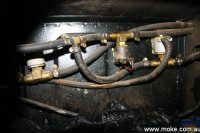
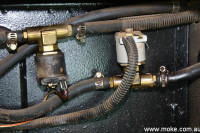
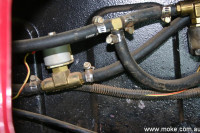
Not as pretty as I would like but there is not a lot of room in the side box and access is difficult but from the images you can see the solenoid on the right turns the supply on or off from the side tank. The middle solenoid controls the supply from the rear tank and then joins the hose going to the fuel pump. The left solenoid shuts off the return pipe to the rear tank unless filling is required.
The set up provides around 700-800km range with the 988 on the open road and although I have never measured it the rear tank is around 35-40 lts when full. Refilling takes 20 minutes or 50km regardless of rpm as the fuel pump is constant and with a little bit of planning you can arrive at the fuel stop with an empty side tank every time ready to take on a fresh 30lts. Switches on the dash operate the solenoids however an early incarnation for the Cape York trip used manual valves over near the passengers knee that could be reached easily when driving.
